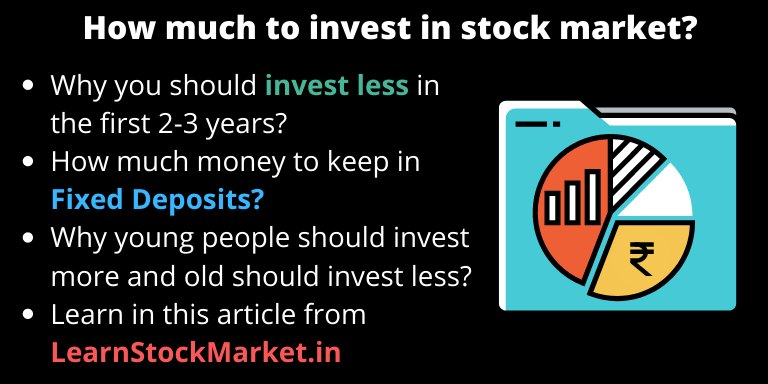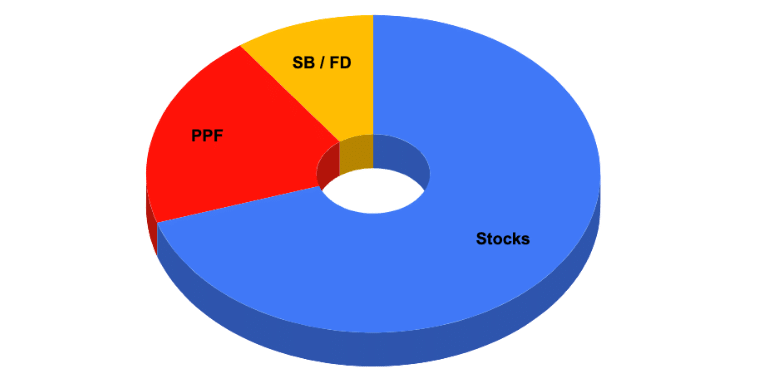
How much to invest in stock market – is a question that every new investor asks.
Many experts say – invest only the amount which you are willing to lose.
While I don’t agree with that statement, investors who are new to the market should take that advice seriously.
Most investors lose money in the first 2-3 years of their investing journey. Once you spend enough time in the market, and experience your first bear market (big fall in prices) – the lessons you learn are for a lifetime.
Your mistakes will reduce with time. You will also begin to understand that protecting your money is more important than chasing big returns in the stock market.
After the initial phase, investing becomes much less riskier – as you begin to take more sensible decisions.
Once you know what you are doing, returns will start coming too and investing more in stocks would begin to make more sense.
Back to the question…
How much to invest in stocks?

Here is what I do:
- Direct Stocks – 70%
- Public Provident Fund (PPF) – 20%
- Savings Account / Fixed Deposit – 10%
As simple as that.
70% are risk investment, 30% are risk free.
A large part of my total savings goes into direct stock investing. I do not invest through mutual funds. I prefer doing my own research and investing directly into stocks I like.
The Public Provident Fund (PPF) is locked for 15 years. But it’s risk-free and helps me save tax under 80c.
This investment has been accumulated over a long period of time and the ‘power of compounding’ has begun to come into effect.
The government pays 7.1%, which is higher than 5-6% that you get from fixed deposits.
Nearly 90% of all my savings are into equity (stocks) and PPF.
The remaining 10% is kept in a Kotak Mahindra Savings Bank account. I have opted for ‘Sweep in and Sweep Out’ which gives me higher rate of interest compared to a normal Savings Bank (SB) account.
This 10% cash can increase to 20-25% depending on the situation in the market. If there is too much euphoria and stock prices are going crazy (like in 2017), I sell stocks that are quoting extreme valuations and keep the money deposited in my Savings Bank account.
The next step is to patiently wait for great investing opportunities. These opportunities usually comes when there is panic selling in the stock market like Demonetisation in 2016 or Covid-related crash in 2020.
The 10% deposited in Savings Bank also acts as an ’emergency fund’ to meet unexpected expenses. Especially during times like Covid-19 when there is a lot of economic uncertainty, liquid cash in a bank account gives peace of mind.
It also gives me the confidence to hold stocks when there is a market crash. If all my money was invested in the stock market, there would be panic. This could lead to selling stocks out of fear.
Every individual has different risk appetite
How much risk are you willing to take?
Some people prefer a fixed monthly salary and keep all their savings in a fixed deposit. These are people with a very low risk appetite.
Some quit their high-paying jobs to start their own companies. Remember the story of Sachin and Binny Bansal, who quit Amazon to start Flipkart? These are people with high-risk appetite.
Now the problem with taking high risk is – the chances of failure is high too. If you succeed, the returns will also be huge. If you fail, the losses are big.
That’s why ‘High Risk = High Reward’.
If you take a risk and you succeed, the satisfaction you get is immense. This is one of the reasons why I prefer direct stock market investment over mutual funds.
Now, it’s important to know exactly what you are doing before taking risks.
Sachin and Binny Bansal gained experience at Amazon and then founded a similar business called ‘Flipkart’ in India.
A child should not attempt to cross a road, because research says their visual judgement and motor skills are not fully developed before the age of 12.
Similarly, someone who is new to the stock market – ends up buying penny stocks thinking it’s ‘high risk for high return’, then it’s not risk, it’s foolishness.
You are not taking a risk, you are committing stock market suicide.
Remember, only about 5-10% of investors make money in the stock market. The rest come, give their money to smarter and more experienced players and quit within 1-2 years.
Before you invest all your savings or even half of your savings in the stock market – you need to learn and gain experience.
There is a steep learning curve here. You have to get psychologically prepared to become a good investor.
Reading books or just buying a few stocks – cannot make you a successful investor.
Once you know what you are doing, you’ll know exactly how much risk is acceptable to you.
Only invest about 5-10% of your savings in the stock market in your first two years of investing. You can invest in equity through mutual funds, where professionals are handling your money for a small fee.
You can also invest in index funds, which charge less. Whatever returns the index gives, will be your returns. For example, if you invest when the Nifty is at 10,000 and it goes to 11,000 in one year, your returns will be 10%.
In short, if you are new to the stock market, buy a few stocks to learn and invest rest of the money in mutual or index funds.
Your Age Matters
This is important.
The older you are, the lesser money you should invest in the stock market.
If you are not married and in your 20s, you can invest 80% or more in equity.
If you are in your 40s, you can invest around 50-60% in stocks.
The rule that many people follow is:
100 – Your Age = Your stock market exposure.
So, if you are 20 years old, you should invest 80% of your savings in the stock market.
If you are 60 years old, only 40% of your savings should be in equity. In fact, people above 60-70 years of age, should have very limited stock exposure – because if the market goes into a prolonged bear-run, then you may not have your hard-earned money when you need it.
If you are a senior citizen and retired – without monthly income – you should ideally not invest the money which you would need in the next 5 years in the stock market.
Youngsters who have steady income and no dependents, can obviously take bigger risks.
I invested almost 90% of my savings in the stock market for the first 5 years. The rest were deposited in PPF to save tax.
If you have any questions, feel free to ask in the comments section below.
The views expressed here are my own opinions. Please consult your financial advisor to better understand your financial situation. Taking informed decisions is important.


This article has become a great source of learning for me. I started investing in the stock market in 2017 and lost a lot of money by investing in mid caps and small caps.
Mistake that I did was.. I sold a piece of land, broke my fixed deposits and invested in the market. In 2018 I lost almost 70% of my money.
Learnt the biggest lesson of my life that one should not invest all money in the stock market when there is a bull run.
If we should.. we have to wait for a correction like it happened during covid and then invest in good companies.
I will also take the advice of 100 minus age exposure in equity very seriously. As we grow older we should take lesser risk. High risk is for youngsters.
I have subscribed to your newsletter.
Thank you for the article